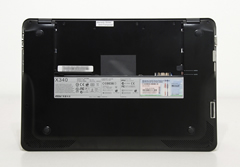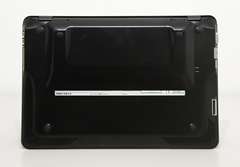MSI X-Slim X340 Features
As its name suggests, the X340 is extremely slim and tapered around the edges to give it an even slimmer look. The system is just a hair thicker than the MacBook Air, measuring .24" at its thinnest point and .78" at the thickest. By comparison, Apple's laptop is a mere .16" and .76", respectively.

The outer lid is black plastic with an embossed MSI logo in white. Looking at the system head-on with the lid closed, you can barely spot eight small LED activity lights in the center along the bottom bezel. From left to right these indicate: Bluetooth, Wireless, Power On, Battery, Caps Lock, Num Lock, Scroll Lock, Hard Drive Activity.
Moving to the right side of the X340 there are two USB 2.0 ports, headphone and microphone jacks and the power connector. The back side of the system is plain aside from the removable battery compartment, while on the left you'll find a VGA out port, Ethernet jack, HDMI port and a 3-in-1 card reader (SD, SDHC, MMC). All of the ports use chrome accents which look slightly tacky in my opinion.


On the bottom is a large battery compartment as well as a SIM card slot and ventilation holes near the front of the system. Also, in what has to be the strangest speaker placement I have ever seen, one speaker is behind the left vent slot, but the other is positioned under the keyboard near the backspace key.
Our review sample came equipped with an 8-cell battery. As you can see on the pictures, it's quite bulky and significantly adds to the overall thickness of the system. When installed and measuring with the lid open, the X340 is roughly .94" thick – a good deal more than MSI's touted .78 inches. This is a bit misleading as all photos on the manufacturer's website show the slimmer 4-cell battery, and thus a thinner looking notebook that's probably closer to their .78" claim.
Also note that there's no way to access the hard drive and memory expansion slots without voiding your warranty, which is something to keep in mind if you are planning on upgrading to a solid state drive for example.




MSI uses magnets in the two top corners of the lid to keep it firmly in place when in the closed position. With the lid open, we find a 13.4" glossy screen with a black bezel, a webcam and microphone on top. The deck surface is similar to that of the Averatec N3400 as there are no additional keys aside from the power button.
The keyboard on the X340 leaves a lot to be desired. The layout is fine, but some keys are shorter than usual. Specifically the Shift, Enter and Backspace keys on the right feel a bit cramped, which is unfortunate seeing that there is plenty of unused real estate on either side of the keyboard to make them full size.
I would be able to overlook those things, but not the quality of the keyboard itself. Buttons have an ever-so-slight concave feel to them, which is alright, but overall the board feels very cheap and mushy, especially near the middle. We noticed a lot of flex even without fully depressing keys. MSI definitely earns some negative marks here for not paying enough attention to the typing experience.
The touchpad is subtly offset to the left. It is molded from the same piece of plastic as the deck and is slightly inset. There is no dedicated button to disable the touchpad like we saw on the Timeline; but not all is lost. The pad on the X340 is nearly half an inch wider than those on both the Averatec N3400 and Timeline 4810T.
Similar to the aforementioned notebooks, the mouse click buttons on the X340 consist of a single piece of plastic, which may look good from an aesthetics point of view, but as I've said before for actual usage I prefer two separate buttons for the left and right-click actions.

